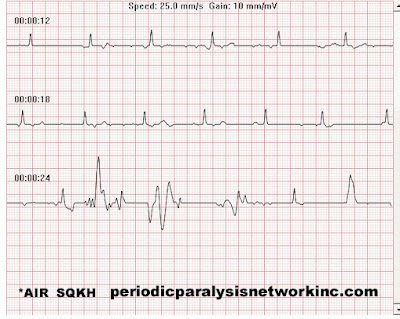Understanding R-on-T Phenomenon in
Periodic Paralysis: An In-Depth Analysis with Focus on Andersen-Tawil Syndrome
Periodic Paralysis (PP) is a group of genetic disorders that cause
episodes of muscle weakness or paralysis due to abnormal ion channel function.
A critical concern for individuals with PP is the occurrence of heart
arrhythmias, particularly the R-on-T phenomenon, which can be life-threatening.
This article explores the relationship between PP and R-on-T arrhythmias,
focusing on the causes, mechanisms, and associated risks, with a specific
emphasis on Andersen-Tawil Syndrome and long-QT intervals.
What is R-on-T Phenomenon?
R-on-T phenomenon occurs when a premature ventricular complex (PVC) lands
on the T wave of the preceding heartbeat. This untimely PVC can disrupt the
heart's normal rhythm, potentially leading to ventricular tachycardia or
ventricular fibrillation, both of which can be fatal. The T wave represents the
repolarization phase of the ventricles, a vulnerable period during which
additional electrical impulses can lead to severe arrhythmias.
Connection Between R-on-T and Periodic Paralysis
Individuals with PP are at an increased risk of experiencing R-on-T
arrhythmias due to fluctuations in potassium levels. Potassium plays a crucial
role in muscle and cardiac function, and imbalances can significantly affect
heart rhythm.
Potassium and Its Role in PP and Arrhythmias
Potassium is essential for maintaining normal electrical activity in
muscle and heart cells. In PP, abnormal potassium levels can lead to:
- Hyperkalemia: High potassium levels can cause
excessive muscle and heart cell excitability, increasing the risk of PVCs.
- Hypokalemia: Low potassium levels reduce
cell excitability but can lead to instability during repolarization
phases, promoting arrhythmias like R-on-T.
Mechanism of R-on-T in Periodic Paralysis
The R-on-T phenomenon in PP patients can be triggered by potassium
shifts, often due to:
- Dietary Factors: High or low potassium intake.
- Medications: Drugs affecting potassium
levels.
- Stress: Emotional or physical stress
can alter potassium balance.
These factors cause premature ventricular depolarization during the
vulnerable repolarization phase (T wave), setting the stage for dangerous
reentrant arrhythmias.
Andersen-Tawil Syndrome and Long-QT Intervals
Andersen-Tawil Syndrome (ATS) is a subtype of Periodic Paralysis
characterized by periodic paralysis, cardiac arrhythmias, and distinct physical
features. One of the hallmark features of ATS is a prolonged QT interval on the
ECG, which increases the risk of developing life-threatening arrhythmias like
Torsades de Pointes.
Long-QT Syndrome: In ATS, mutations in the KCNJ2 gene affect potassium channels, leading
to prolonged repolarization of the heart (long-QT interval). This prolonged QT
interval makes the heart more susceptible to R-on-T phenomenon, where a PVC can
occur during the vulnerable phase of repolarization, leading to dangerous
arrhythmias.
Preventing and Managing R-on-T in Periodic Paralysis
- Regular Monitoring: Frequent monitoring of
potassium levels to maintain a balance.
- Diet Management: Controlled potassium intake
through diet.
- Avoiding Triggers: Minimizing stress and avoiding
medications that affect potassium levels.
Detailed Examination of Triggers and Management
- Dietary Factors:
- Hyperkalemia Triggers: Foods high in potassium, such
as bananas, oranges, and potatoes, can exacerbate hyperkalemia. Managing
dietary intake to maintain optimal potassium levels is crucial. For
instance, a diet low in potassium might be necessary for individuals with
Hyperkalemic Periodic Paralysis.
- Hypokalemia Triggers: Conversely, inadequate
potassium intake or excessive intake of certain medications can lead to
hypokalemia, triggering episodes. Foods like spinach, avocados, and sweet
potatoes can help manage hypokalemia.
- Medications:
- Potassium-Influencing Drugs: Diuretics, commonly used to
manage hypertension, can lead to hypokalemia. Conversely,
potassium-sparing diuretics can cause hyperkalemia. Understanding the
impact of these medications and working with healthcare providers to find
alternatives is essential.
- Stress Management:
- Emotional and Physical Stress: Stress can induce potassium
shifts by activating the body's stress response, which includes the
release of hormones like cortisol and adrenaline. Techniques such as
mindfulness, yoga, and cognitive-behavioral therapy (CBT) can be
effective in managing stress levels.
- Regular Monitoring:
- Continuous Monitoring: Using wearable devices to
monitor heart rhythm and potassium levels can provide real-time data,
helping to prevent episodes. Regular check-ups with a cardiologist are
also recommended.
- Emergency Protocols:
- Action Plans: Developing an action plan for
acute episodes, including emergency medication and hospital protocols,
ensures swift and effective response to arrhythmias.
Research and Case Studies
Research has highlighted the intricate relationship between potassium
levels and cardiac function in PP patients. Case studies demonstrate the
life-saving potential of meticulous potassium management and stress reduction
strategies.
Example Case Study: A study in the Journal of Clinical Cardiology documented a case
where a patient with Hyperkalemic Periodic Paralysis experienced a severe
R-on-T episode triggered by a high-potassium meal. Through dietary management,
the patient's arrhythmias were successfully controlled.
Conclusion
Understanding and managing the risks associated with R-on-T phenomenon in
individuals with Periodic Paralysis is crucial. By maintaining stable potassium
levels, avoiding known triggers, and implementing comprehensive monitoring and
emergency protocols, the risk of life-threatening arrhythmias can be
significantly reduced.
References
- Ho, M., & Zhang, L. (2019).
Mechanisms of R-on-T premature ventricular complexes and their clinical
implications. Circulation: Arrhythmia and Electrophysiology.
Retrieved from AHA Journals.
- Siegal, S. L. (n.d.). R on T
Premature Ventricular Complexes (PVC) Simplified. ECGEDU.com.
Retrieved from ECGEDU.
- Narayanan, K. (2023). Advances in
the understanding of R-on-T phenomenon and its clinical implications. ScienceDirect.
Retrieved from ScienceDirect.
Image: A photo of my own R on T captured on an EKG



No comments:
Post a Comment